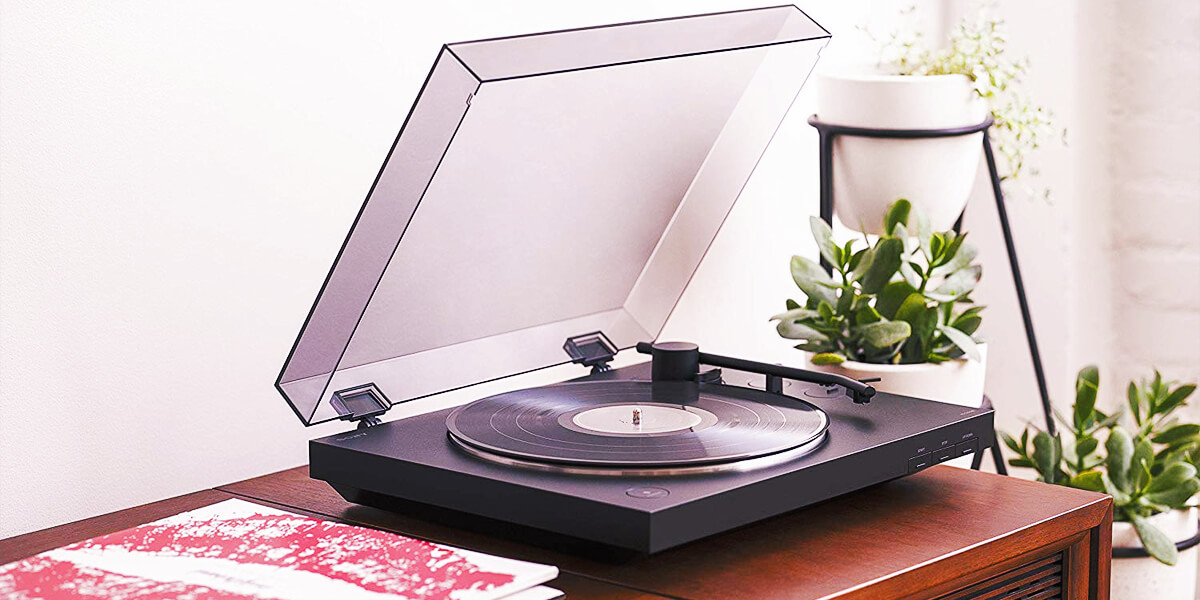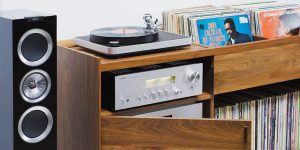Vinyl turntables have long captivated music enthusiasts with their warm and authentic sound reproduction. However, choosing the perfect record player can be a daunting task. In this article, I’ll help you unravel the mystery behind the eternal debate: belt-drive vs. direct-drive turntable. I’ll cover the differences between these two types of record players, so you can make an informed decision and find the one that suits your needs and preferences. So, let’s embark on this audio adventure together!
Belt-drive turntables

Pros of belt-drive turntables
Reduced vibration and enhanced sound quality
One notable advantage of belt-driven turntables is their ability to minimize disruptive vibrations. The carefully positioned drive belt acts as a buffer, effectively isolating the motor from the platter.
So, it promotes cleaner, more accurate sound reproduction.
Easy maintenance and replacement
Maintenance for belt-driven vinyl players is a breeze. The drive belt, an important component, can be easily replaced if needed, ensuring optimal performance. This uncomplicated maintenance process allows you to keep your treasured vinyl collection spinning smoothly without any hassle.
Accessible options at various price points
For those seeking a more economical choice, belt-drive turntables offer an array of accessible options. Whether you’re a casual listener or an entry-level audiophile, quality turntables are available to suit different budgets. So, you don’t have to dig deep into your pockets to savor the distinct charm of vinyl playback.
Cons of belt-drive turntables
Slower start-up and speed adjustment
One aspect to consider with this type of turntable is the relatively slower start-up time compared to other models. The initial rotation requires a brief moment as the belt transfers the motor’s force to the platter.
Additionally, adjusting the speed on a belt-driven vinyl player may involve manual manipulation of the belt or pulley system.
Belt wear and eventual replacement
Over time, the drive belt may experience wear and tear. Various factors, such as usage, environmental conditions, and storage practices, can contribute to the degradation of the belt. The good news is that belt replacements are usually affordable and straightforward to carry out.
Limited suitability for djing and scratching
If you aspire to be a DJ or have a penchant for vinyl scratching, it’s important to note that belt-drive turntables may not be a perfect choice. These vinyl players typically have lower torque and may lack the quick start-up and speed stability required for such techniques. Professional DJs focused on scratching often usually prefer other turntable models.
Direct-drive record players

Pros of direct-drive record players
Faster start-up and accurate speed control
One of the notable advantages of direct-drive record players is their ability to achieve faster start-up times. With a direct connection between the motor and the platter, these vinyl players offer quicker rotation, allowing you to dive into your music without delay.
Additionally, direct-drive systems provide precise speed control, ensuring accurate playback of your beloved vinyl records.
Greater durability and stability
These players are renowned for their robust construction and stability. The motor is directly integrated into the platter, eliminating the need for belts or pulleys.
This design enhances overall durability, reducing the likelihood of mechanical failures over time.
Ideal for djing and professional use
Direct-drive players have long been favored by DJs and professionals in the music industry. Their high torque motors enable quick start and stop times, making them perfect for scratching, beatmatching, and other DJ techniques.
Cons of direct-drive record players
Potential for increased vibration and noise
While direct-drive turntables offer many advantages, they can be prone to increased vibration and noise compared to other systems. The direct motor connection can transmit subtle vibrations to the platter, which may affect the overall sound quality.
However, modern direct-drive models often incorporate innovative technologies and dampening materials to minimize these effects, providing a more enjoyable listening experience.
Higher price range
These vinyl players generally come with a higher price tag compared to belt-drive options. The advanced motor technology and engineering involved in their construction contribute to the elevated cost.
However, I recommend considering the long-term value and durability that direct-drive turntables offer, making them a worthwhile investment for serious audiophiles and professional DJs.
More complex maintenance and repairs
Maintaining and repairing direct-drive turntables can be more complex compared to other systems. Due to their intricate motor design, specific technical knowledge may be required for certain repairs.
When making a decision about which turntable to choose, it is essential to carefully consider the pros and cons of this option. Factors such as intended use, budget, and desired sound quality should be taken into account to ensure that you make an informed choice.
Selecting the right turntable for you

When selecting the ideal turntable for your needs, it’s essential to consider whether a direct drive or belt drive player aligns with your intended use. So let’s look at some factors to help you make an informed decision.
Assessing your needs
- Casual listening. If your goal is to enjoy your vinyl collection at home and appreciate the rich sound, a belt-drive player might be the ideal choice. This option offers a balance of affordability and impressive sound quality.
- DJing and professional use. For those who aspire to become DJs or require a turntable for professional use, a direct-drive turntable is the way to go.
Evaluating your budget
It’s important to consider your budget when selecting a vinyl player. Belt-drive turntables tend to be more budget-friendly, offering accessible options across various price ranges.
On the other hand, direct-drive models often come with a higher price point due to their advanced features and durability.
Remember to consider both the initial cost and potential long-term maintenance expenses.
Prioritizing sound quality and performance
The choice between belt drive and direct drive has an impact on sound quality and overall performance. Let’s explore the pros and cons of each:
- Vibration reduction. Belt-drive turntables are known for their excellent vibration reduction capabilities, allowing for a more immersive and distortion-free sound experience.
- Pitch stability. Both belt-drive and direct-drive turntables can provide stable pitch performance. However, direct-drive models excel in precise speed control.
- Noise levels. With their reduced vibration, Belt-drive turntables tend to produce less mechanical noise.
It’s important to note that sound quality is influenced by various factors beyond the drive system.
When choosing turntables, it’s important to understand all the key differences between direct-drive and belt-drive systems. Here is a summary table:
| Features | Belt-Drive | Direct-Drive |
|---|---|---|
| Vibration Reduction | Excellent | Good |
| Speed Control | Good | Excellent |
| Durability | Good | Excellent |
| Noise Levels | Low | Moderate |
| Suitable for DJing | Less suitable | Ideal |
| Price Range | Affordable | Higher |
By carefully evaluating your needs, budget, sound quality priorities, and maintenance considerations, you’ll be well-equipped to decide between a direct-drive or belt-drive turntable that suits your requirements perfectly. Happy listening!








